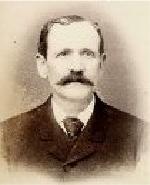 A large framed orginial print of this picture hung in the Franklin Hotel lobby for years. This is "Comanche" the horse which was the only living thing found on Custer Hill after the June 25th 1876 Battle of the Little Big Horn or whatever it is called today.
A large framed orginial print of this picture hung in the Franklin Hotel lobby for years. This is "Comanche" the horse which was the only living thing found on Custer Hill after the June 25th 1876 Battle of the Little Big Horn or whatever it is called today.
From Wikipedia 8/31/07:
Comanche was a mixed Mustang Morgan horse who survived General George Armstrong Custer's detachment of the US 7th Cavalry at the Battle of the Little Bighorn.
He was bought by the U.S. Army in 1868 in St. Louis, Missouri and sent to Fort Leavenworth, Kansas. Captain Myles Keogh of the 7th Cavalry liked the 15 hand bay gelding and bought him for his own personal mount, to be ridden only in battle. In 1868, while fighting the Comanche in Kansas, the horse was wounded in the hindquarters by an arrow, but continued to let Keogh fight from his back. Thus the horse was named “Comanche” to honor his bravery. Comanche was wounded many more times, always exhibiting the same toughness.
On June 25, 1876, Captain Keogh rode Comanche at the Battle of the Little Bighorn, led by Lt Col. George Armstrong Custer. The battle became famous when their entire detachment was killed. Comanche was found two days after the battle, badly wounded. After being transported by steamboat to Fort Lincoln, he was slowly nursed back to health.
After a lengthy convalescence, Comanche was retired and orders were given that he should never be ridden again. As an honor, he was made “Second Commanding Officer” of the 7th Cavalry. At Fort Riley, he became something of a pet, occasionally leading parades and indulging in a fondness for beer.
Comanche died in 1890. He is one of only two horses in United States history to be buried with Full Military Honors, the other being Black Jack http://www.aaa.com/aaa/006/EnCompass/2004/jun/jun_GuardingHistory.html
His remains were sent to the University of Kansas and preserved, where they can still be seen.
Comanche is often described as the sole survivor of Custer's detachment, but like so many other legends surrounding the Little Bighorn battle, this one is false. As historian Evan S. Connell writes in Son of the Morning Star: "Comanche was reputed to be the only survivor of the Little Bighorn, but quite a few Seventh Cavalry mounts survived, probably more than one hundred, and there was even a yellow bulldog.
Comanche lived on another fifteen years, and when he died, he was stuffed and to this day remains in a glass case at the University of Kansas. So, protected from moths and souvenir hunters by his humidity-controlled glass case, Comanche stands patiently, enduring generation after generation of undergraduate jokes. The other horses are gone, and the mysterious yellow bulldog is gone, which means that in a sense the legend is true. Comanche alone survived."
Email from University of Kansas 8/31/07:
Hello and thank you for your inquiry. Yes, we have the preserved (taxidermied) remains of Comanche housed in an exhibit on the fourth floor of our museum in Lawrence, Kan. He was preserved by naturalist Lewis Lindsay Dyche. You can read about our efforts to move Comanche from one exhibit into a modern one and see several photographs at http://www.nhm.ku.edu/Hdocs/Comanche.html
Jen Humphrey
Communications Director
KU Biodiversity Institute
KU Natural History Museum

























